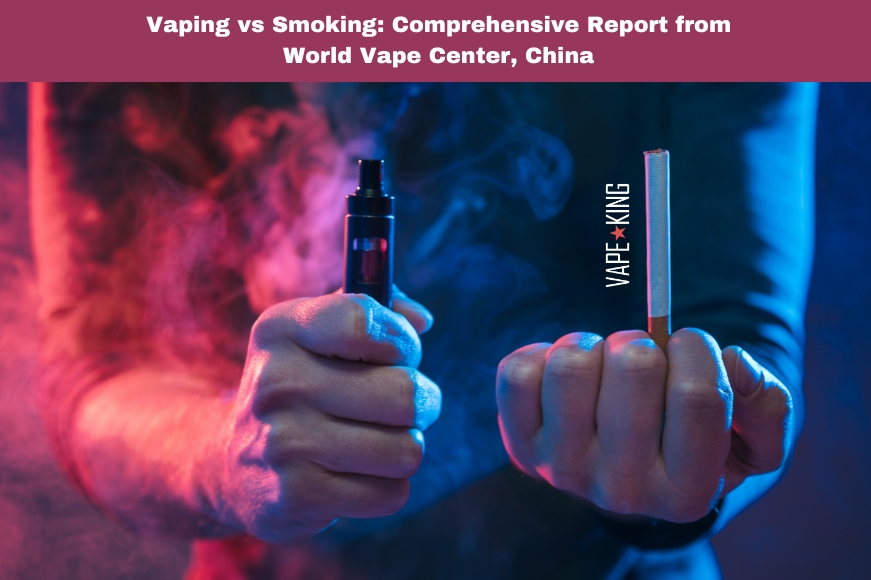Free Shipping on orders R1000 or more!
Examining E-Cigarettes vs. Traditional Cigarettes: Insights from China's Vaping Industry

As global calls for smoking bans increase, scrutiny around e-cigarettes intensifies with numerous reports questioning their safety. Amidst growing regulatory pressure, this analysis explores the realities of e-cigarettes versus traditional cigarettes, using data primarily from China—the epicenter of the global e-cigarette industry.
Comparative Health Impacts: Smoking vs. Vaping
Toxicological Comparison
Traditional cigarettes emit numerous harmful substances when burned, including tar, nicotine, phenols, alcohols, acids, and aldehydes—all known for their detrimental health effects. In contrast, e-cigarettes contain propylene glycol (PG), vegetable glycerin (VG), optional nicotine, and flavors, which are significantly less harmful.
Table: Toxic Substance Comparison
Data Source: Heated Tobacco Products: Insights into Composition and Toxicity – Swapna Upadhyay, 2023
Health Impact Analysis
According to the 2023 study “Heated Tobacco Products: Insights into Composition and Toxicity,” e-cigarettes contain significantly lower levels of harmful substances compared to traditional cigarettes. Supported by a survey of 2,000 people, 68.1% of participants reported improved health symptoms such as reduced coughing and sore throats after switching to vaping.
Table: Reported Health Improvements
Data Source: Heated Tobacco Products: Insights into Composition and Toxicity – Cai Yuyang, 2023
Attraction to Non-Smokers and Minors
Vaping’s Appeal
Contrary to popular belief, data indicates that e-cigarettes are not a significant gateway to smoking for non-smokers or minors. In China, 92% of e-cigarette users were already smokers, suggesting that vaping primarily attracts those seeking less harmful alternatives to smoking.
Table: E-cigarette Appeal to Non-Smokers
Data Source: Heated Tobacco Products: Insights into Composition and Toxicity – Cai Yuyang, 2023
Efficacy in Smoking Cessation
Reduction in Cigarette Use
Vaping has proven to be an effective tool for smoking cessation, helping users reduce or quit traditional cigarette use. The reduction in daily cigarette use is substantial among participants.
Table: Smoking Reduction via Vaping Data Source: Heated Tobacco Products: Insights into Composition and Toxicity – Cai Yuyang, 2023

Regulatory Perspectives and Public Health
Understanding Regulatory Impacts
With the increasing prevalence of vaping, governments worldwide are crafting policies that balance public health interests with individual rights. The focus has been on preventing underage vaping through stringent regulations while allowing adults access to safer alternatives.
Table: Regulatory Focus on Vaping

Public Health Perspectives
Public health officials advocate for a nuanced approach to e-cigarette regulation, considering both potential harms and benefits. The overarching goal is to reduce smoking rates while preventing new addiction cycles among youth.
Social Implications and Media Influence
Media Narratives and Social Perception
The media plays a pivotal role in shaping public perception of vaping. Often, sensational news about the risks associated with vaping can overshadow potential benefits. It’s crucial to approach these reports critically and consider the broader public health context.
Table: Media Influence on Public Perception

Conclusion
This comprehensive analysis, supported by extensive data from China, confirms that e-cigarettes are a less harmful alternative to traditional cigarettes and an effective cessation tool. The key challenge lies in regulating effectively to ensure vaping remains a beneficial option for adults trying to quit smoking while preventing its adoption by minors.
- Sharri Van Zyl | 01/07/2024
No posts found
Write a review

